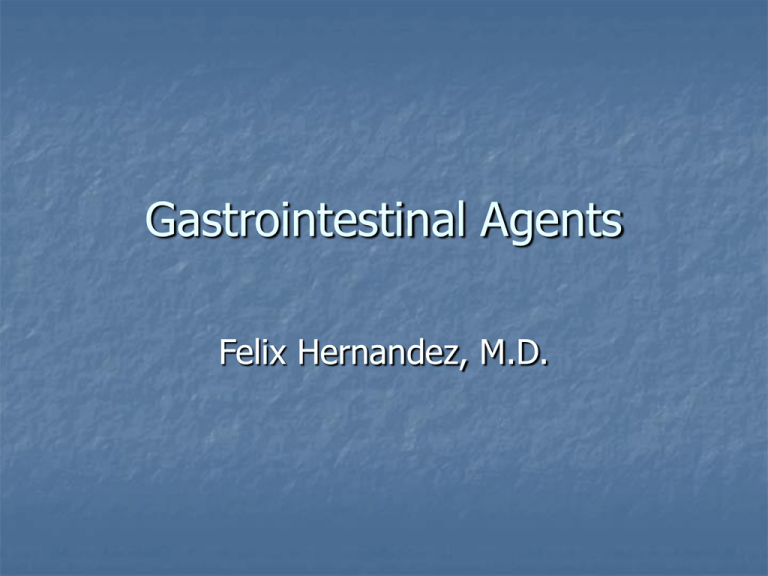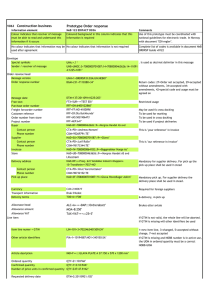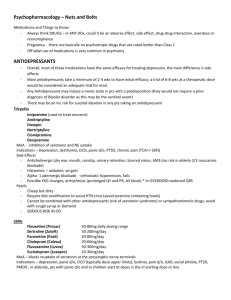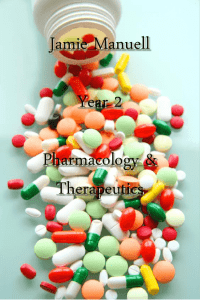
Gastrointestinal Agents
Felix Hernandez, M.D.
Acid Reducing Agents
Histamine Receptor Blockers:
MOA: Histamine receptor Antagonist
Indications: duodenal/gastric ulcer, hypersecretion of
acid, GERD
Side Effects: Well tolerated. Diarrhea, decreased libido,
impotence. Can be hepatotoxic and renal toxic
Interactions: increases concentration of anticoagulants
Drugs:
Cimetidine (Tagamet)
Ranitidine (Zantac)
Famotidine (Pepcid)
Acid Reducing Agents
Antacids
Aluminum Salts
Calcium Carbonate
MOA: same
Indications: same
Side effects: constipation, hypercalcemia, metabolic alkalosis, milk-alkali
syndrome (rare)
Magnesium Salts
MOA: Neutralize gastric acid thus causing a reduction in mucosal irritation. Relief
of pain precedes healing.
Indications: symptomatic relief of gastric acid irritation
Side Effects: constipation, hypercalcemia, hypophosphatemia
Notes: Magnesium antacids are co administered to prevent constipation
MOA: same
Indications: same
Side Effects: diarrhea, hypermagnesemia N/V, hyporeflexia, decreased muscle
tone
Sodium Citrate
MOA: same
Indications: Pre-op antacid
Side Effects: Horrible taste but is likely to cause aspiration pneumonitis because it
is nonparticulate
Acid Reducing Agents
Sucralfate (Carafate)
MOA: Sucrose and polyaluminum hydroxide
polymerize at low pH to form a protective
coating
Indications: Prophylaxis and treatment of
duodenal ulcers
Side Effects: Constipation
Interferes with the absorption of fluroquinolone
AB
Proton Pump Inhibitors
Drugs: Omeprazole (Prilosec), Lansoprazole
(Prevacid), Esomeprazole (Nexium), Pantoprazole
(Protonix)
MOA: inhibits hydrogen/potassium ATPase (Proton
pump) of the parietal cells thus reducing acid
secretion.
Indications: reflux esophagitis, duodenal ulcers,
hypersecretory states
Side Effects: Constipation (few side effects)
Omeprazole interacts with warfarin, phenytoin and
diazepam
Dysmotility Agent
Metoclopramide (Reglan)
MOA: increases rate of gastric emptying by an
unknown mechanism
Indications: reflux esophagitis, gastroparesis,
pre-op gastric emptying
Side Effects: diarrhea, constipation, can cause
extra-pyramidal side effects due to dopamine
antagonism (elderly and children)
Increases the toxicity of antipsychotics
Mucosal Protectant
Misoprostol
MOA: increases bicarbonate and mucin release in
the GI tract and reduces acid secretion
Indications: prevention of ulcers caused by
aspirin and other NSAIDS
Side Effects: Abortion (uterine contraction),
diarrhea, abdominal pain, flatulence
Contraindications: PREGNANCY!!!!
Is a prostaglandin analog
Antidiarrheal Agents
Opiates
Diphenoxylate and Atropine (Lomotil)
MOA: diphenoxylate is an agonist at opiate receptors in the GI
tract and atropine blocks muscarinic receptors. Both of these
actions inhibit peristalsis
Indications: Diarrhea
Side Effects: few such as constipation, abdominal/bowel
distention
Contraindications: Parasitic or bacterial infections, obstructive
jaundice
Increased risk of paralytic ileus with antimuscarinics
Loperamide (Imodium)
No drug interactions
Treat OD with Naloxone
Antidiarrheal Agents
Absorbents
Bismuth Subsalicylate (Pepto-Bismol)
MOA: absorbs toxins produced by bacteria and other GI irritants
Indications: Diarrhea, prophylaxis for traveler’s diarrhea
Side Effects: Impaction
Contraindications: Aspirin sensitivity
Potentiates oral anticoagulants
Kaolin/Pectin (Kaopectate)
MOA: adsorbent and protection that is of questionable efficacy
Indications: diarrhea
Side effects: may increase potassium loss or interfere with
absorption of drugs and nutrients
Contraindications: obstructive bowel lesions
Antidiarrheal Agents
Cholestyramine (Questran)
MOA: absorbs bile salts (they cause diarrhea)
and C. difficile toxin
Indications: Diarrhea caused by C. difficile or bile
acids
Side Effects: constipation
Mainly used for lipid disorders
Inflammatory Bowel Agents
Mesalamine and Sulfasalazine
MOA: anti inflammatory
Indications: inflammatory bowel syndrome, UC
or Crohn’s
Will cover more of this drug in a later chapter
Bulk Forming Agents
Psyllium (Metamucil)
MOA: nondigested plant cell wall absorbs water
into feces thus softening the stool
Indications: constipation, hard stools
Side Effects: flatulence, impaction if the bolus is
obstructed
Stimulant Laxatives
Bisacodyl (Dulcolax)
MOA: increases water and electrolytes in feces
and increases intestinal motility
Side Effects: continuous use may cause diarrhea
Milk of Magnesia
Milk of Magnesia (saline solutions)
MOA: magnesium or sodium salts are poorly
absorbed and thus draw water into the lumen.
High dose rids bowel of parasites and empties bowel
preoperatively
Side Effects: precipitation of cardiac, renal,
convulsive disorders or hypocalcaemia
Castor Oil
MOA: metabolized in the intestine to
ricinoleate. It is a surfactant which decreases
water and electrolyte absorption and
increases motility
Side Effects: cramps. Chronic use must be
avoided due the risk of dehydration,
electrolyte imbalance and nerve damage
Polyethylene Glycol (MiraLax)
MOA: hyperosmolarity draws water into the
colon
Side Effects: cramps, N, bloating
Lactulose (Chronulac)
MOA: Hyperosmolarity draws water into the
colon. Gets metabolized in the intestine to
lactate which acts as a laxative osmotically
and by lowering the pH
Side Effects: cramps, flatulence, N/V
Mineral Oil
MOA: Lubricates feces and prevents
absorption of water from feces
Side Effects: anal leakage and irritation,
reduces vitamin absorption
Can develop aspiration pneumonitis with oral
administration
Docusate (Colace)
MOA: improves penetration of water and fat
into feces
Side Effects: diarrhea, abdominal cramps.
It increases the absorption of mineral oil so
do not use together with mineral oil
Obesity Management
Orlistat (Xenical)
MOA: reversible lipase inhibitor therefore it
inhibits the absorption of fats from the intestine
Should be accompanied by a balanced reduced
calorie diet
Multivitamin supplements are needed because
vitamin absorption is decreased by the drug
Patient will have fatty/oily stool












